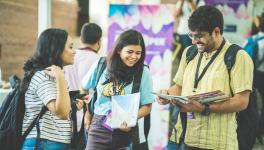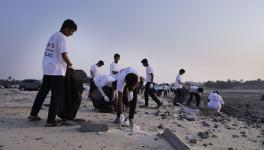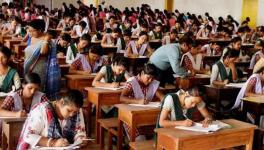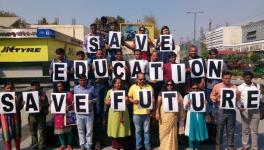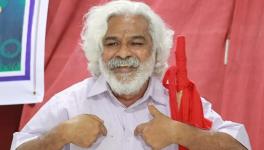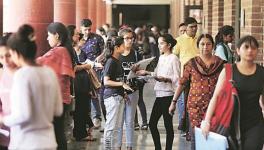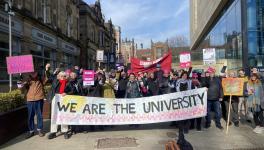Multi-Layered Disparities in Telangana's Scholarship Programmes for Studies Abroad

Representational Image. Image Courtesy: Rawpixel
On August 19, Telangana’s Minister for Municipal Administration and Information Technology, Kalvakuntla Taraka Rama Rao (KTR), tweeted that he was travelling to the United States to admit his son for undergraduate studies. He also mentioned that he would be holding official meetings during his trip. As KTR embarks on his journey to the United States as both a Minister and a father who is seeking to provide his son with a quality education abroad, it contrasts with the challenges experienced by Telangana's overseas scholarship students from caste-oppressed and religious minority backgrounds, who have similar aspirations.
Analysing the caste and class hierarchy here is important given the increasing number of Indian international students across Global North countries, where, for instance, the 2022-23 academic year witnessed students from India becoming the largest group in the United States, surpassing Chinese students. Of this, students from Andhra Pradesh and Telangana are among the highest-represented groups, making it crucial for us to interrogate the landscape of education, access, capital, and government scholarships that marginalised students within this subgroup are navigating.
Striking Irregularities in Public Data
Thus, against the backdrop that Telugu-speaking students aspire to pursue higher education in the United States, a dream destination, we explore the decade-long implementation of the Ambedkar Overseas Vidya Nidhi (AVON) Scholarship constituted by the United Andhra Pradesh Government in June 2013 (G.O. Ms. No. 54) for Scheduled Caste-Tribe (SC-ST) students of the state, the budget for which was allocated from the Scheduled Caste-Tribe Sub-Plan. This scheme was continued after the formation of Telangana in 2014 with a modification of the scholarship amount from Rs 10 lakh (as per the average conversion rate in 2013, USD 17,200) to Rs 20 lakh (as of August 2023, USD 24,200).
It is vital to note that while the scheme promised 500 scholarships for SC students per year at its inception, ten years later, we do not see this commitment mirrored in the data. Since 2014, the state has only sent 953 SC students abroad. This amounts to an average of less than 100 students annually in the past decade and an estimated budget of Rs 20 crore for Dalit students to study abroad, already excluding the cost of one-way flight tickets, visa expenses and the mandatory standardised exam training.
Speaking to NewsClick, a recent graduate of this programme, who hails from the SC community, shared her experience of the barriers and delays she had to face in availing of the scholarship amount promised. She only received her first instalment 11 months after joining her course. At the time of writing this article, she is yet to receive the second instalment of her scholarship money despite having completed her programme of study.
Another student, who joined during the Spring session in the North American university, told us that even after eight months of joining his programme, he was yet to receive the first instalment of his scholarship, putting him under immense pressure. Another student enrolled in a top European university was forced to come back and continue studying remotely so that they could follow up with the concerned government offices due to payment delays and the additional financial burden they were experiencing.
Similar is the case for scholarships implemented by the Tribal Welfare Department of Telangana for ST students. As per the publicly available data for the academic years 2020-21 and 2021-22, the budget allocation for the Ambedkar Overseas Vidhya Nidhi for ST students was estimated at 448.5 lakhs. However, in the year 2021-22, 38 candidates were shortlisted. This alone means that if each student were given their due Rs 20 lakh, the total budget required would be 760 lakhs. This speaks to the deficit of roughly Rs 300 lakhs in the basic allocation of funds for students to comfortably benefit from this scheme as intended by the state. Again, these costs exclude one-way flight tickets, standardised exams training costs, and visa expenses.
In conversation with tribal applicants for the scheme, who already joined their universities abroad, NewsClick learned that their applications are yet to be approved at the district-level Tribal Welfare Offices (TWO) before they can progress to the next stage of review. One of the students shared that while he had completed his application in June, it was still stuck at the district TWO, alluding to the bureaucratic delays and inefficiencies in the process.
Further, alongside SC-ST students, the schemes launched for religious minority (2015) and Backward Caste (2016) students bring the total number of beneficiaries to 6,352 between 2014 and 2022 and accumulate a government expenditure of Rs 863.49 crores as per the Telangana Socio-Economic Outlook Report, 2023. Assuming that each student was given their due Rs 20 lakh, only 4,320 students could have gone through the process (without the above-excluded expenses), leaving little to no provision for the remaining 2,032 students.
Further, a 2022 article by Ashok Danavath on the Mahatma Jyotiba Phule Backward caste overseas scholarship (MJPOVN) programme reported that the Backwards Castes/Classes Welfare Minister, Gangula Kamalakar, shared in the Telangana state Assembly session that between 2016-2019, 1,113 students benefited from the programme. However, this data contradicts the RTI information of the concerned state department in 2021. Further, given that 300 students must be selected for this scheme every year, between 2016-2022, we would have seen a total of 2,100 BC beneficiaries. However, the Outlook Report claims 2,976 MJPOVN scholarship recipients, leaving more than 800 students unaccounted for.
While there is no disagreeing that these schemes look equitable on paper, compared to other states in India and across South Asia as a whole, because it ensures Rs 20 lakh in scholarship to students from marginalised castes, classes and religious minorities communities, the above data contradictions prove that the budget allocation and implementation processes do not follow suit.
Analysis
Our analysis of the budget allocation and implementation process of these scholarship programmes is grounded solely in the reality that the aspiration and movement for the creation of Telangana itself, emerged from a socialist and social justice-centric praxis, as opposed to a capitalist agenda nurtured by neoliberal policies. Although the present government is pro-welfare schemes, its focus on creating jobs and economic growth through the influx of an Information Technology boom within the state begs an important interrogation: Who does this benefit?
Indeed, the feudal caste, who are heavily represented as policymakers in the state, further these aspirations within a capitalistic framework. Certainly, this reality is mirrored in the implementation of scholarship schemes by the state as well, where ministers (KTR himself is an alumnus of The City University of New York) and their children are able to benefit from overseas education in furthering their careers. Yet, they do not prioritise the financial mobility or well-being of the marginalised communities for whom they are designing and implementing these programmes. More often than not, this leaves students from marginalised backgrounds to chase down payments and fend for themselves.
In opposition to these capitalist objectives, peoples’ movements call for the democratisation of land and resources so that even the most marginalised in the state can access them. Such politics is crucial in a state like Telangana, which was not only formed and fought for on such anti-class and anti-caste intentions but also because of the geographic and socio-economic organisation of the state, wherein almost 90% of the people belong to historically marginalised backgrounds. For the people, then, an IT revolution and flourishing feudalism are not the answer.
People are seeking more equitable access to land, water, and institutions, including education. Dalit, Adivasi, and other marginalised caste and religious minority students, as well as scholars with disabilities or from the transgender community, need systematic elevation. The history of knowledge production gatekeeping and limited access, fueled by casteist and feudalistic processes in the region, demands equity for these communities. This differs significantly from the capitalist idea of "assistance," underscoring the need for accountability and transparency.
Reflecting on SC student scholarships, we find that despite the Andhra Pradesh government's commitment to providing 500 scholarships in 2013, a decade later, the Dalit community has suffered a decline in the number of scholars studying abroad and their financial prospects due to poor scheme implementation. If even half of the intended students (i.e., 250) had been sent in the past decade, we would have witnessed 2500 scholars from the programme. These scholars could have influenced these scholarship programmes' guidance, review, and implementation. In the case of Adivasi students, the initial government orders do not specify the committed number of students.
It is critical to note that while the budget is already insufficient in providing the students with what the government intends to, they also do not give students their scholarship amount to take care of their expenses when in need, causing a lapse in using the allocated funds for the year in question.
For instance, in the case of the Mahatma Jyotiba Phule Backward caste overseas scholarship (MJPOVN) programme, we see a total of Rs 19.04 crores being lapsed in the year 2018-19, after which we see that only Rs 33.53 crores were allocated in the year 2020-21, and was further reduced to Rs 33.00 crores. This reduction of over 50% of the budget allocated to the scheme over the past few years could only occur because of the lapses in adequately supporting recipients. However, the numbers make it seem like the intended budget was actually too high and thus, its allocation had to be curbed to ensure efficiency.
Recommendations
Speaking with a Dalit beneficiary of the scheme who collaborates with fellow recipients in the US, we discovered that students face significant challenges. One major issue is the restrictions on international students' work permits, both in terms of hours and job type. In her own experience, the delayed release of her scholarship funds caused immense financial stress. She could only work 20 hours per week on campus, which didn't generate enough income to cover accommodation and living expenses, let alone support her graduate programme. Additionally, working part-time jobs to make ends meet leaves students, especially first-generation learners, with little time and energy to focus on their studies, which negatively impacts their academic experience.
When scholarship payments are delayed, students can't register for classes or meet the required unit minimum, jeopardising their visa status. Some students resort to taking additional loans with interest, further increasing their financial burden. This situation is particularly challenging for first-generation Dalit and Adivasi learners who lack the social and cultural capital and family connections in foreign countries to help them during such crises. The anxiety and trauma of this experience are compounded because students' families are often involved, and they lack collateral to rely on back home.
Against this backdrop, we recommend that instead of giving only partial financial assistance, which ends up posing so many challenges during the course of study, Dalit and Adivasi students should be given full scholarships to study at QS 1500 ranking universities. For example, if the Tribal Welfare Department of Telangana allocates Rs 50 crore per year and one crore rupees were spent on each student, 40-50 Adivasi (ST) students can receive overseas education annually, inclusive of flight, visa, and maintenance costs. Given that only 249 students have been sent in the past decade, only 25 students have cycled through on a yearly basis, which would be a significant improvement. Similarly, if an annual budget of 100 crore Rs was allocated for Dalit (SC) students, at least 100 students could benefit every year.
Further, that Dalit, Adivasi, and religious minority students, alongside student leaders, activists, scholars, and social scientists, are not part of these implementation processes is reflected in these discrepancies. It is not sufficient that government officials and professors from the Jawaharlal Nehru Technological University, Hyderabad, head the screening and implementation of these schemes, given the need for a cautious and humble sensibility around the issues of social and cultural capital and justice that schemes such as these are attempting to grapple with.
Lastly, apart from making the recipients and social scientists key stakeholders in the screening processes, it is crucial to revisit the schemes in their entirety as we approach the end of this first decade, and bring the scholarship awards for students at par with inflation rates, in the various countries that students are being sent to, with a reaffirmed commitment to supporting scholarship production by and financial mobility for historically marginalised communities in the state.
Ashok Danavath works with the National Campaign on Dalit Human Rights as a Senior Researcher. Radhika Marwaha is a graduate student at UC San Diego’s Ethnic Studies Program.
(Views expressed are personal)
Get the latest reports & analysis with people's perspective on Protests, movements & deep analytical videos, discussions of the current affairs in your Telegram app. Subscribe to NewsClick's Telegram channel & get Real-Time updates on stories, as they get published on our website.









